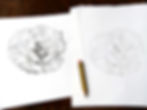research trip - The British Museum - Mrs Delaney - paper cuts and embroidery
- Stephanie Smart
- May 2, 2018
- 6 min read
Updated: Jul 12
"Paper cutting is an art with a long history. Its first origins date back to the 4th century after the invention of the paper by the Chinese. Some of their earliest uses for paper cutting were for religious decorations or stencils used for patterns in embroidery. For a long time, this art form was popular among high-society women, but it soon spread to other classes. Paper cutting practices ranged from the skilled craftsman to its evolution into the folk art world. People displayed paper cut designs in windows, as paper lanterns, and on furniture, just to name a few."
https://www.xacto.com/blog?cid=history-paper-cutting#:~:text=Paper%20cutting%20is%20an%20art,used%20for%20patterns%20in%20embroidery.

Elizabeth Cobbold (British, 1767-1824) - A paper cut out sillhouette of exotic birds.
I have come across paper cutting as an art form fairly frequently during research into the 1700 and 1800's. You can see an example here. The paper cut silhouette can be said to have democratised portraiture certainly during the Regency. Previous to that it was only the great and the good who could afford to have their images captured by an artist (in oils, on a large canvas to be hung on a large wall). Silhouette cutters were found at the end of seaside piers and all over in cities and town. Average people posed, then walked away with what might also be classified as the first selfie. To rea more about paper cut silhouettes please see my post Silhouettes and the self-image
One of the first women I discovered working in this field however, was Mary Delaney. As the quote above says it was often practised by high-society women and Mary is an example of this, attending the royal court regularly as she did. She was 72 in 1772 when she began producing her "Paper Mosaicks". The dates of her life, 1700 - 1788, mean that she knew Britain during the reigns of George II and his grandson George III.
Immediately I was spellbound. I found her work poignant, informative and important. She began as a child cutting paper silhouettes (profiles or shades, as they were also known at the time). She would cut complete paper scenes of the sort you can see above by Elizabeth Cobbold but Mary would distinguish herself by her interest in botanical subject matter, which inspired her to heights arguably unknown before or since. It seems she might have invented what we know now as paper collage.

Papaver somniferum, the Opium Poppy, Bulstrode, October 18 1776
photographed from The Paper Garden by Molly Peacock
Really her work is astounding, her eyesight and the unwavering surety of her hands (therefore of each cut line) is quite incredible. Immediately I'd begun reading about her work I wanted to start practicing. Immediately I began practising I realised how hard it would be to produce work of a similar quality.
Early on in her book The Paper Garden Molly Peacock informs her readers that Mary's paper flowers survive, preserved in the drawing and prints archives of the British Museum, making them available for limited viewing. The more I worked on my own version of a red poppy the more I knew I needed to see real examples of Mary's work, to hold them close in order to examine the cut lines which seem invisible in reproductions. My appointment date arranged with the department I continued experimenting. I began by drawing...


...moved onto quilling...



...then made early, shabby attempts at mimicry re. paper mosaicking...

Still, unhappy with the results I was achieving I was delighted when the day of my visit finally came.
It was exciting to climb the stairs to the fourth floor of the British Museum, at the time arranged, and to then sit for an hour in the drawing and prints storage/viewing library with a pair of white gloves, a box of images and a viewing easel. Each visitor is allowed to see only a single box of 8-10 images because they are, unsurprisingly, fragile and indeed popular. I wasn't surprised to hear the latter said about them but I did wonder why it had taken me so long to come across their existence if, apparently, everyone else knows about them. Anyway, each page I held had been taken from Mary's original albums and mounted. In fact they remain remarkably well preserved considering they are now well over 200 years old.
You can see the collection of Paper Mosaicks by Mary Delaney that the British Museum holds at:
http://www.britishmuseum.org/research/collection_online/search.aspx?people=127351&peoA=127351-2-9&page=1 But here are a few of the close up details:
I'll confess I was looking for, and photographing, in part, the areas that make evident the fact that these works were made by human hands, the areas that make clear that glue was used, and can be messy. I went there hoping to find areas of the works that, under close inspection, would be seen to be less impressive, more real, slightly scrappy. Not because I meant to undermine her achievement but because I was needing to know that the technique was achievable. I needed to see for myself that Mrs D would have struggled at moments with real materials and that she might have made mistakes. I needed to be sure that, as I suspected, the visual perfection when closely scrutinised might be found in fact to be formed from a mass of slightly rough-edged, abstracted elements.
Currently there are two examples of her work in the Enlightenment Gallery on the ground floor of the museum also and I made sure I saw those too. When seen set back behind glass Mary's flowers appear as finished, complete and perfect as they do in books.
It was only holding them that allowed me to see them as they actually are, pieces which, like any work of art, might have been worked on further, were it not for the fact that something told her in each case to stop. Pieces that have been formed from some magic combination of imperfections, happy accidents of combinations of shapes and blended colours of the sort that only someone with skill and an eye for such things can conjure.
To read more about Mary's mosaicks please click here
Paper cuts and embroidery
Then I discovered, thanks to the Gardens Trust whom I quote below. For on their website you can find a post about a Georgian fire screen which turns out not to be just a fire screen but part of a panel for a dress and on it Mary's paper cut botanicals are seen translated using silk thread and integrated with fashion in the form of a dress.

part of an apron designed by Mary Delaney c.1740
© the Gardens Trust
"...It was so fine that when the owner died her heirs took the dress apart, divided it up and framed the best sections...the dress was designed by Mary Pendarves [later Mrs Delany]...and the dress – strictly speaking a petticoat for a court mantua – shows that her botanical knowledge and craft skills were immense...the dress has, according to garden historian Mark Laird, “the most accurate horticultural detailing of any work I’ve seen from this period.”...Clothes defined status and social standing, and in this case, in conjunction with Mary’s many letters, give an insight into not only how fashions change but importantly how flowers and plants were perceived and appreciated...Perhaps as a result by the 1740s, the mantua was worn only at court, although as a gown style it continued to evolve slowly through the rest of the 18th century. Although totally impractical, one of the reasons it was fashionable was because it ostentatiously displayed the enormous quantity of rich and expensive cloth that was needed to create it...Black was an unusual colour choice, because the fashion was definitely for pale coloured fabrics which were thought to allow for greater contrasts between light and shadow in the fabric’s drapery as it moved. Although it’s usually associated with mourning, in Mary’s case her unlamented husband had been dead for about 15 years so its much more likely wearing something this ornate, probably with a lighter coloured gown on top was simply a bold fashion statement. She adopted the same technique when in later life she created her botanical collages, laying them out on a black background...It was once thought that she did the embroidery on the petticoat herself, and she writes of creating cross-stitch pieces for furnishings such as screens and chair seats. But, apart from the time involved in something so complex there are several reasons why this is now thought unlikely. Many of the flowers are raised up with padding, which enhances their realism by giving them a 3-dimensional effect. However to do this well is a highly skilled technique thought only to have been in the repertoire of a experienced and professional embroiderer and probably outside the range of skills of even a gifted amateur. Indeed Mary names several such talented professional needlewomen admiringly in correspondence. There are also several references which suggest that she did indeed employ skilled craftswomen for dress making and furnishing work, and, if she is honest in her letters, she rarely showed the same enthusiasm for needlecraft as for the many other crafts she did practice."
It was fascinating to find an artist (amateur hardly does her justice given she lived in a very different time in terms of the possibilities for the lives of women) who linked paper (cuts) and fabric in this way. She would not be the last I would find. Four or five years after I came across Mary I would discover the work of Anna Maria Garthwaite (a professional silk designer) who would inspire me likewise with a paper cut she created as a 17 year old.
Thank you for reading.





































